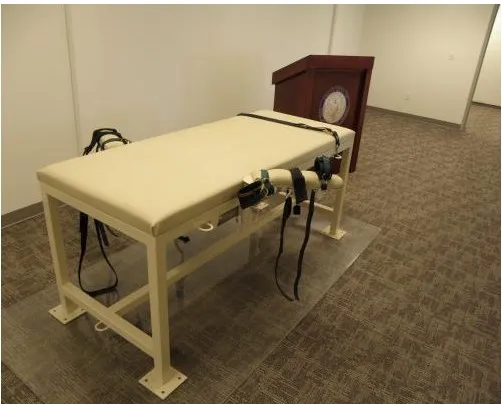The execution chamber at the Idaho Maximum Security Institution south of Boise. (Courtesy of IDOC)
This story was first published by Idaho Reports on Sept. 18, 2024.
The Idaho Department of Correction is renovating the execution chamber at the Idaho Maximum Security Institution near Kuna, according to building permits from the Division of Occupational and Professional Licenses.
The change comes after the failed execution attempt of 74-year-old Thomas Creech on Feb. 28, in which the medical team could not establish an IV line to carry out his execution by lethal injection. The department called off his execution.
On Wednesday, IDOC spokesperson Sanda Kuzeta-Cerimagic verified the work is happening in an area of the facility known as the F block, where IDOC carries out executions.
“In order to comply with (Idaho law), which requires us to have the ability to carry out an execution by firing squad, we have implemented a phased approach to retrofitting the F Block, our current execution chamber,” Kuzeta-Cerimagic wrote in an email to Idaho Reports. “Phase one of the F Block retrofit included making modifications to the existing configurations and is nearing completion. We are currently in phase two of the retrofit, evaluating design and layout options for accommodating a firing squad.”
The building permits do not outline the renovation details, and Kuzeta-Cerimagic said she could not elaborate.
Idaho Reports filed a record request on Tuesday for copies of the renovation plans but did not receive an immediate response.
Idaho Department of Correction working on central-line facility, documents indicate
But other records hint at possible plans. In at least two pieces of recent litigation, attorneys for those on death row have brought up the potential of IDOC changing its policy to use a central vein to kill a person.
A central vein is a major vein in the body, usually in the chest, neck or groin. Access to a central vein requires the insertion of a catheter. A peripheral vein is closer to the skin’s surface, such as in the arm or hand, commonly used in things like blood draw or establishing an IV line on a patient. IDOC’s current execution procedure, last modified in 2021, did not allow the medical team to use a central vein or establish a catheter in the central vein on Creech during the last execution attempt.
In a Sept. 13 filing in pending federal lawsuit filed by Gerald Pizzuto Jr., another man on Idaho’s death row, Pizzuto asked IDOC for its newest execution procedures. On April 17, the complaint states Pizzuto, 68, was informed that IDOC was amending the execution procedure. Pizzuto’s lawsuit claims that as late as Sept. 3, IDOC indicated it was working on construction of the central-line facility, which was not yet complete “because certain equipment had not yet been delivered.”
Documents dated June 10 say when questioned, Idaho Department of Correction director Josh “Tewalt admits IDOC will use an appropriately licensed and credentialed volunteer to insert a central line. Defendant Tewalt further admits insertion of a central line is within that person’s scope of practice. So far, the volunteer who will place the central line has not been given a designation.”
“Our execution policy remains under review, and it will be made available to the public at a later time,” wrote Kuzeta-Cerimagic.
The statements made in litigation do not mean IDOC has formally changed its policy. IDOC policy does not require the department to host public meetings regarding a change in execution procedure. Instead, the decision is left to Tewalt.
During a House Judiciary, Rules and Administration Committee meeting on Feb. 29, while being questioned about Creech’s failed execution, legislators asked Tewalt about the use of a central vein.
“It’s a very different legal threshold that we have to establish where we are not practicing medicine with the intent to save a life,” Tewalt told legislators. “In fact, it’s the exact opposite.”
Alabama corrections used a central intravenous line in the past during executions by lethal injections where a peripheral line could not be established.
The state of Idaho does allow the use of the firing squad as an execution method, but does not yet have a complete facility constructed to carry out a death by firing squad.
There are no current death warrants for any of Idaho’s death row residents.
GET THE MORNING HEADLINES DELIVERED TO YOUR INBOX

